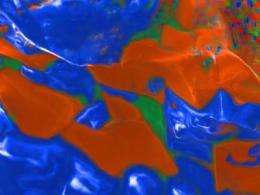Are those liquids explosive?

A team of researchers from the University of the Basque Country (Spain) has developed a method to determine the chemical composition of liquids seized by police and suspected to be explosive. Some of the samples analysed contained substances hazardous to health, such as methanol and boric acid.
Each year police forces seize tonnes of pyrotechnic substances which, in principle, are for indoor firework manufacturing (i.e. flares or those used in artistic or sporting events), but which also may end up in the hands of violent groups and hooligans.
A group of chemists from the University of the Basque Country (UPV/EHU, Spain) has developed a method that offers judges conclusive scientific tests on the nature of these liquids. Until now, many resources have been allocated to detecting high explosives such as TNT, but very few for less powerful ones which can also be dangerous.
"We have found a relatively simple way to detect explosive or flammable compounds in suspicious liquids, by combining four techniques commonly used in laboratories," stated Kepa Castro, UPV/EHU researcher and the study's lead author.
On one hand, the molecular composition of the substances is obtained using two spectroscopy techniques (Raman and infrared) that can be performed with mobile devices in airports, customs or ports offices.
On the other hand, energy-dispersive spectroscopy (EDS) combined with scanning electron microscopy (SEM) images is used to determine which elements are in the sample.
"With the SEM-EDS technique we are able to observe how the sample's elements are distributed and grouped (for example, calcium with sulphur suggests that calcium sulphate is present)" explains Castro, "and by crossing data from four different techniques, we are able to check and confirm the results."
Samples with dangerous compounds
To check the method, the scientists applied it to five seized liquid samples. Four of the samples presented substances used in indoor fireworks. Alcohols, such as isopropyl and methanol, are used to solubilise compounds and the scientists managed to produce coloured flames with them.
The team was surprised to find methanol being used as a main solvent, given that this compound is very toxic for human beings, causing acidosis and blindness, and it is restricted in many countries.
Boric acid was also detected in one of the other sample liquids. This substance has recently been added to the list of Substances of Very High Concern (SVHC) as part of the European Union's REACH Regulation (Registration, Evaluation, Authorisation and Restriction of Chemical substances). These acids can have a negative effect on the human reproduction system.
Strangely, no flammable or explosive substances were found in the fifth sample. "It is probably a flame retardant, which is precisely used in fire prevention," suggested the researcher.
More information: Kepa Castro, Silvia Fdez-Ortiz de Vallejuelo, Izaskun Astondoa, Félix M. Goñi, Juan Manuel Madariaga. "Are these liquids explosive? Forensic analysis of confiscated indoor fireworks". Analytical and Bioanalytical Chemistry 400:3065, 2011. DOI:10.1007/s00216-011-5013-4
Provided by FECYT - Spanish Foundation for Science and Technology



















